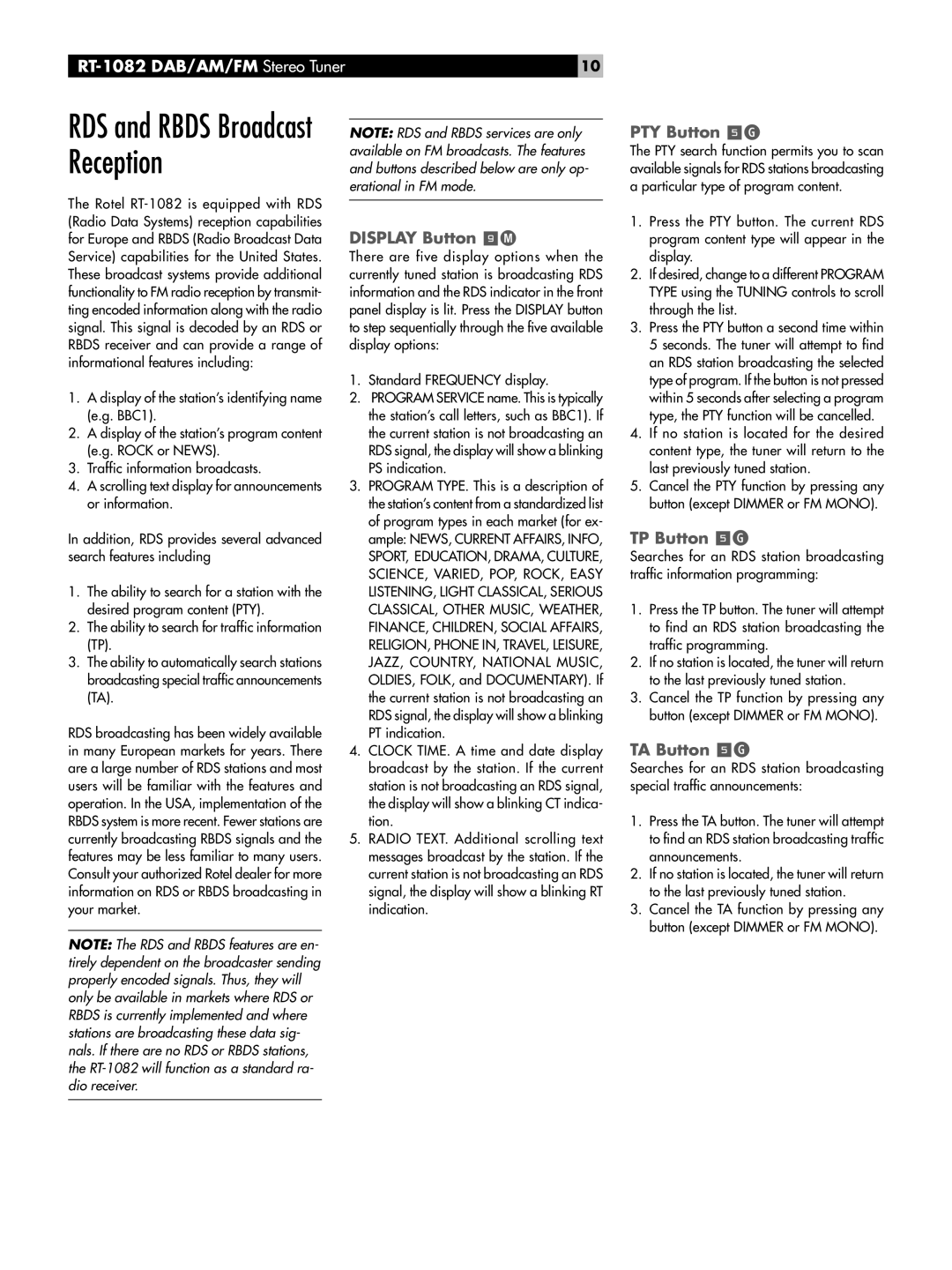
RT-1082 DAB/AM/FM Stereo Tuner
RDS and RBDS Broadcast Reception
The Rotel
1.A display of the station’s identifying name (e.g. BBC1).
2.A display of the station’s program content (e.g. ROCK or NEWS).
3.Traffic information broadcasts.
4.A scrolling text display for announcements or information.
In addition, RDS provides several advanced search features including
1.The ability to search for a station with the desired program content (PTY).
2.The ability to search for traffic information (TP).
3.The ability to automatically search stations broadcasting special traffic announcements (TA).
RDS broadcasting has been widely available in many European markets for years. There are a large number of RDS stations and most users will be familiar with the features and operation. In the USA, implementation of the RBDS system is more recent. Fewer stations are currently broadcasting RBDS signals and the features may be less familiar to many users. Consult your authorized Rotel dealer for more information on RDS or RBDS broadcasting in your market.
10
NOTE: RDS and RBDS services are only available on FM broadcasts. The features and buttons described below are only op- erational in FM mode.
DISPLAY Button 9M
There are five display options when the currently tuned station is broadcasting RDS information and the RDS indicator in the front panel display is lit. Press the DISPLAY button to step sequentially through the five available display options:
1.Standard FREQUENCY display.
2.PROGRAM SERVICE name. This is typically the station’s call letters, such as BBC1). If the current station is not broadcasting an RDS signal, the display will show a blinking PS indication.
3.PROGRAM TYPE. This is a description of the station’s content from a standardized list of program types in each market (for ex- ample: NEWS, CURRENT AFFAIRS, INFO,
SPORT, EDUCATION, DRAMA, CULTURE, SCIENCE, VARIED, POP, ROCK, EASY LISTENING, LIGHT CLASSICAL, SERIOUS CLASSICAL, OTHER MUSIC, WEATHER, FINANCE, CHILDREN, SOCIAL AFFAIRS, RELIGION, PHONE IN, TRAVEL, LEISURE, JAZZ, COUNTRY, NATIONAL MUSIC, OLDIES, FOLK, and DOCUMENTARY). If the current station is not broadcasting an RDS signal, the display will show a blinking PT indication.
4.CLOCK TIME. A time and date display broadcast by the station. If the current station is not broadcasting an RDS signal, the display will show a blinking CT indica- tion.
5.RADIO TEXT. Additional scrolling text messages broadcast by the station. If the current station is not broadcasting an RDS signal, the display will show a blinking RT indication.
PTY Button 5G
The PTY search function permits you to scan available signals for RDS stations broadcasting a particular type of program content.
1.Press the PTY button. The current RDS program content type will appear in the display.
2.If desired, change to a different PROGRAM TYPE using the TUNING controls to scroll through the list.
3.Press the PTY button a second time within 5 seconds. The tuner will attempt to find an RDS station broadcasting the selected type of program. If the button is not pressed within 5 seconds after selecting a program type, the PTY function will be cancelled.
4.If no station is located for the desired content type, the tuner will return to the last previously tuned station.
5.Cancel the PTY function by pressing any button (except DIMMER or FM MONO).
TP Button 5G
Searches for an RDS station broadcasting traffic information programming:
1.Press the TP button. The tuner will attempt to find an RDS station broadcasting the traffic programming.
2.If no station is located, the tuner will return to the last previously tuned station.
3.Cancel the TP function by pressing any button (except DIMMER or FM MONO).
TA Button 5G
Searches for an RDS station broadcasting special traffic announcements:
1.Press the TA button. The tuner will attempt to find an RDS station broadcasting traffic announcements.
2.If no station is located, the tuner will return to the last previously tuned station.
3.Cancel the TA function by pressing any button (except DIMMER or FM MONO).
NOTE: The RDS and RBDS features are en- tirely dependent on the broadcaster sending properly encoded signals. Thus, they will only be available in markets where RDS or RBDS is currently implemented and where stations are broadcasting these data sig- nals. If there are no RDS or RBDS stations, the
